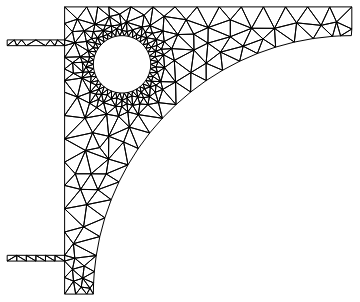ThisThese should work:
Method 1
EditMethod 2
All of these methods are documented in ToBoundaryMesh. There you can find more info.
Method 3
Here is yet another way to do it, but that will requite version 11.2:
L = 1./5; d = 1./50; r = L - d; r1 = d; L2 = 1./250; L3 = 1./25; L4 =
L/8;
reg = RegionDifference[
RegionUnion[Rectangle[{0, 0}, {L, L}],
Rectangle[{-L3, L4 - L2/2}, {0, L4 + L2/2}],
Rectangle[{-L3, (L - L4) - L2/2}, {0, (L - L4) + L2/2}]],
RegionUnion[Disk[{L, 0}, r], Disk[{2 d, L - 2 d}, r1]]];
Now we make boundary discretizations of the components and construct the region from those:
bdr = BoundaryDiscretizeRegion /@ reg[[2]];
bmr = Fold[RegionDifference, bdr]
Next, we create a NumericalRegion and attach the boundary mesh to it:
Needs["NDSolve`FEM`"]
nr = ToNumericalRegion[reg, RegionBounds[reg]];
bmesh = ToBoundaryMesh[bmr];
SetNumericalRegionElementMesh[nr, bmesh];
When we now mesh that numerical region have both the symbolic and the boundary representation available and a good approximation can be generated:
mesh = ToElementMesh[nr];
mesh["Wireframe"]
To compare the area of the mesh with the area of the symbolic representation we use:
narea = Total[mesh["MeshElementMeasure"], 2];
and
L = 1/5; d = 1/50; r = L - d; r1 = d; L2 = 1/250; L3 = 1/25; L4 =
L/8;
reg2 = RegionDifference[
RegionUnion[Rectangle[{0, 0}, {L, L}],
Rectangle[{-L3, L4 - L2/2}, {0, L4 + L2/2}],
Rectangle[{-L3, (L - L4) - L2/2}, {0, (L - L4) + L2/2}]],
RegionUnion[Disk[{L, 0}, r], Disk[{2 d, L - 2 d}, r1]]];
sarea = Integrate[1, {x, y} \[Element] reg2];
The result:
narea - sarea
-2.4810104379269227`*^-7
I think this is quite good.





